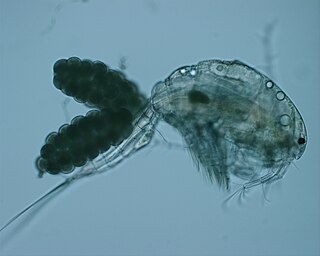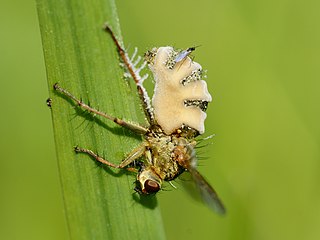Related Research Articles

Mosquitoes are approximately 3,600 species of small flies comprising the family Culicidae. The word "mosquito" is Spanish for "little fly". Mosquitoes have a slender segmented body, one pair of wings, one pair of halteres, three pairs of long hair-like legs, and elongated mouthparts.

Parasitism is a close relationship between species, where one organism, the parasite, lives on or inside another organism, the host, causing it some harm, and is adapted structurally to this way of life. The entomologist E. O. Wilson characterised parasites as "predators that eat prey in units of less than one". Parasites include single-celled protozoans such as the agents of malaria, sleeping sickness, and amoebic dysentery; animals such as hookworms, lice, mosquitoes, and vampire bats; fungi such as honey fungus and the agents of ringworm; and plants such as mistletoe, dodder, and the broomrapes.

Flies are insects of the order Diptera, the name being derived from the Greek δι- di- "two", and πτερόν pteron "wing". Insects of this order use only a single pair of wings to fly, the hindwings having evolved into advanced mechanosensory organs known as halteres, which act as high-speed sensors of rotational movement and allow dipterans to perform advanced aerobatics. Diptera is a large order containing an estimated 1,000,000 species including horse-flies, crane flies, hoverflies, mosquitoes and others, although only about 125,000 species have been described.

In biology and medicine, a host is a larger organism that harbours a smaller organism; whether a parasitic, a mutualistic, or a commensalist guest (symbiont). The guest is typically provided with nourishment and shelter. Examples include animals playing host to parasitic worms, cells harbouring pathogenic (disease-causing) viruses, or a bean plant hosting mutualistic (helpful) nitrogen-fixing bacteria. More specifically in botany, a host plant supplies food resources to micropredators, which have an evolutionarily stable relationship with their hosts similar to ectoparasitism. The host range is the collection of hosts that an organism can use as a partner.

Aedes albopictus, from the mosquito (Culicidae) family, also known as the (Asian) tiger mosquito or forest mosquito, is a mosquito native to the tropical and subtropical areas of Southeast Asia. In the past few centuries, however, this species has spread to many countries through the transport of goods and international travel. It is characterized by the white bands on its legs and body.

Anopheles or Marsh Mosquitoes is a genus of mosquito first described and named by J. W. Meigen in 1818. About 460 species are recognized; while over 100 can transmit human malaria, only 30–40 commonly transmit parasites of the genus Plasmodium, which cause malaria in humans in endemic areas. Anopheles gambiae is one of the best known, because of its predominant role in the transmission of the most dangerous malaria parasite species – Plasmodium falciparum.

Beauveria bassiana is a fungus that grows naturally in soils throughout the world and acts as a parasite on various arthropod species, causing white muscardine disease; it thus belongs to the group of entomopathogenic fungi. It is used as a biological insecticide to control a number of pests, including termites, thrips, whiteflies, aphids and various beetles. Its use in the control of bedbugs and malaria-transmitting mosquitos is under investigation.

Mosquito control manages the population of mosquitoes to reduce their damage to human health, economies, and enjoyment. Mosquito control is a vital public-health practice throughout the world and especially in the tropics because mosquitoes spread many diseases, such as malaria and the Zika virus.

The Nematocera are a suborder of elongated flies with thin, segmented antennae and mostly aquatic larvae. This group is paraphyletic and contains all flies but species from suborder Brachycera, which includes more commonly known species such as the housefly or the common fruit fly. Families in Nematocera include mosquitoes, crane flies, gnats, black flies, and multiple families commonly known as midges. The Nematocera typically have fairly long, fine, finely-jointed antennae. In many species, such as most mosquitoes, the female antennae are more or less threadlike, but the males have spectacularly plumose antennae.

Ceratopogonidae is a family of flies commonly known as no-see-ums, or biting midges, generally 1–3 millimetres in length. The family includes more than 5,000 species, distributed worldwide, apart from the Antarctic and the Arctic.

The Phlebotominae are a subfamily of the family Psychodidae. In several countries, their common name is sandfly, but that name is also applied to other flies. The Phlebotominae include many genera of blood-feeding (hematophagous) flies, including the primary vectors of leishmaniasis, bartonellosis and pappataci fever. In the New World, leishmaniasis is spread by sand flies in the genus Lutzomyia, which commonly live in caves, where their main hosts are bats. In the Old World, sand flies in the genus Phlebotomus spread leishmaniasis.

Blastocladiomycota is one of the currently recognized phyla within the kingdom Fungi. Blastocladiomycota was originally the order Blastocladiales within the phylum Chytridiomycota until molecular and zoospore ultrastructural characters were used to demonstrate it was not monophyletic with Chytridiomycota. The order was first erected by Petersen for a single genus, Blastocladia, which was originally considered a member of the oomycetes. Accordingly, members of Blastocladiomycota are often referred to colloquially as "chytrids." However, some feel "chytrid" should refer only to members of Chytridiomycota. Thus, members of Blastocladiomyota are commonly called "blastoclads" by mycologists. Alternatively, members of Blastocladiomycota, Chytridiomycota, and Neocallimastigomycota lumped together as the zoosporic true fungi. Blastocladiomycota contains 5 families and approximately 12 genera. This early diverging branch of kingdom Fungi is the first to exhibit alternation of generations. As well, two (once) popular model organisms—Allomyces macrogynus and Blastocladiella emersonii—belong to this phylum.

Mesocyclops is a genus of copepod crustaceans in the family Cyclopidae. Because the various species of Mesocyclops are known to prey on mosquito larvae, it is used as a nontoxic and inexpensive form of biological mosquito control.

Entomophthora is a fungal genus in the family Entomophthoraceae. Species in this genus are parasitic on flies and other two-winged insects. The genus was circumscribed by German physician Johann Baptist Georg Wolfgang Fresenius (1808–1866) in 1856.

Mandayam Osuri Tirunarayana Iyengar was an Indian medical entomologist who worked on management of filaria and malaria vectors. He was employed as an entomologist in the Department of Malaria Research, Bengal. The mermithid parasite Romanomermis iyengari and the mosquito species Culex iyengari are named after him.
Michael Francis Madelin (1931–2007) was a British mycologist. He held research faculty positions at Imperial College, University of London, and the University of Bristol, and undertook pioneering research in conidial fungi and slime moulds, with specific reference to their physiology and ecology.

Hydrachnidia, also known as "water mites", Hydrachnidiae, Hydracarina or Hydrachnellae, are among the most abundant and diverse groups of benthic arthropods, composed of 6,000 described species from 57 families. As water mites of Africa, Asia, and South America have not been well-studied, the numbers are likely to be far greater. Other taxa of parasitengone mites include species with semi-aquatic habits, but only the Hydracarina are properly subaquatic. Water mites follow the general Parasitengona life cycle: active larva, inactive (calyptostasic) protonymph, active deutonymph, inactive tritonymph and active adult. Usually, larvae are parasites, while deutonymphs and adults are predators.
Howard C. Whisler (1931–2007) was an American mycologist. Born in Oakland, California, he attended Berkeley schools and then Palo Alto High School. Howard worked on his undergraduate degree at Oregon State College for two years and then went to the University of California, Berkeley, where he completed a Bachelor of Science degree in plant pathology in 1954. He joined the United States Air Force from 1954 to 1956 stationed in Italy. He returned to University of California, Berkeley after his military life and had finished his doctoral degree with Ralph Emerson in 1960. From 1960 to 1961 he held a post doctoral NATO-NSF Fellowship in France, at the Université de Montpellier. Howard was appointed assistant professor of Botany at McGill University in 1961. He was appointed to the faculty at the University of Washington on March 15, 1963 and worked until he died on September 16, 2007, at the age of 76.

Amoebidium is a genus of unicellular, symbiotic eukaryotes in the Opisthokont group Mesomycetozoea, family Amoebidiidae. Amoebidium species attach to the exoskeleton of freshwater aquatic arthropods such as midge larvae and water fleas (Daphnia). The type species is Amoebidium parasiticum, which is also one of the only species to be cultured axenically.
Meristacrum is a fungal genus in the monotypic family Meristacraceae, of the order Entomophthorales. They are parasites of soil invertebrates, they typically infect nematodes, and tardigrades.
References
- ↑ Keilin, Parasitology 13: 226 (1921)
- ↑ "Part 1- Virae, Prokarya, Protists, Fungi". Collection of genus-group names in a systematic arrangement. Archived from the original on 14 August 2016. Retrieved 30 June 2016.
- ↑ The Genus Coelomomyces. John Couch , ISBN 978-0-12-192650-2
- ↑ Sumbali, Geeta (2005). The Fungi. Alpha Science. p. 54. ISBN 1-84265-153-6.
- ↑ "Coelomomyces - Mycobank" . Retrieved 2016-09-01./